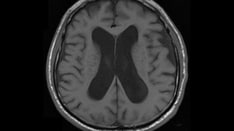This transcript has been edited for clarity.
Dear colleagues, I am Christoph Diener from the Faculty of Medicine at the University Duisburg-Essen in Germany. This video deals with four positive studies that were presented at the European Stroke Organisation Conference in Munich at the end of May 2023. This congress was exciting because it's the first time in many years that, beyond thrombectomy, we had positive studies.
ENRICH Intracerebral Hemorrhage
Let me start with intracerebral hemorrhage. Surgical therapy of intracerebral hemorrhage was a disaster until now. We had a number of randomized studies that were, unfortunately, unable to show neurosurgery benefits for people with supratentorial bleeding, like stage 1 and 2. We even had a study with minimally invasive surgery, which had a strong trend, but it was not significant.
Now we have a new study, the ENRICH study, and this is the first positive study. This study included 300 patients with spontaneous bleeding into the basal ganglia or lobar hemorrhages, with a size between 30 and 80 mm. These patients were subjected to either control or minimally invasive surgery within 24 hours. The endpoint was modified Rankin after 180 days.
This study was positive in favor of the intervention, with an odds ratio of 0.63, and this was significant from day 7 onward. The postoperative imaging showed an 88% reduction in the volume of the bleeding. The death rate was 3.3% vs 18%. The number needed to treat for mortality was 21 and to prevent severe disability was 14.
Importantly, the therapy was not really effective for basal ganglia bleeding but mostly for lobar hemorrhages. This is an extremely important study because, for the first time, neurosurgical treatment was superior to control.
INTERACT3: BP For Stroke Management
The next study, published in The Lancet, was INTERACT3. Until now, we had no really convincing conservative therapy of spontaneous intracerebral bleeds except for lowering blood pressure, which showed a very strong trend in the INTERACT2 study, which was published in 2013 and investigated rapid lowering of systolic blood pressure in more than 2700 patients.
INTERACT3 was a cluster randomized trial done in low- and middle-income countries, mostly in China. They included more than 7000 patients in 121 hospitals, and these patients were randomized within 6 hours. The active treatment group received four different therapeutic strategies, including lowering systolic blood pressure to less than 140 mm Hg, strict glucose control, treatment of elevated temperature, and antagonization of anticoagulation. This was compared to standard of care. The primary endpoint was a shift analysis of the modified Rankin scale at 6 months.
The patients were, on average, 62 years old, 64% were men, and most of these patients were treated on neurosurgical wards. The really positive result is, for the first time, a significant benefit of this bundle of four different therapies with an odds ratio of 0.86, which was clearly significant, and a number needed to treat of 35. There was also a significant reduction in mortality by 23%, with the number needed to treat of 35. Most importantly, the most severely affected patients had the highest benefit.
This is an extremely important study because, for the first time, structured medical treatment was superior to control in the treatment of intracerebral hemorrhage.
ELAN: Anticoagulation Post Ischemic Stroke
The ELAN study, published in The New England Journal of Medicine, addresses a very important question — namely, when to start anticoagulation in people with atrial fibrillation who had an ischemic stroke. If you start too late, there is an increased risk for recurrent stroke. If you start too early, there is a risk of bleeding into the ischemic area.
This study was done in 103 hospitals in 15 countries, and it compared early anticoagulation with late anticoagulation. "Early" means that anticoagulation was initiated within 48 hours in mild to moderate strokes, and at 6-7 days in severe strokes. Late anticoagulation was day 3-4 for mild stroke, 6-7 for moderate stroke, and day 13-14 after severe stroke. The primary endpoint was a combination of ischemic stroke, systemic embolism, severe systemic bleeding, symptomatic intracranial bleeding, or vascular death at 30 days.
This study had more than 2000 patients, and about one third with mild stroke, small strokes, and severe strokes. The primary endpoint was achieved in 29 patients, which is 2.9% with early treatment in 41 patients and 4.1% for late treatment. The difference was 1.18%. Statistically, it was not significant, but there was a clear trend.
For recurrent stroke, the odds ratio was 0.6, which would translate to a 40% reduction in the risk for recurrent ischemic stroke, and this was statistically significant. Symptomatic intracranial hemorrhage was not a problem. There were two cases in the two treatment groups.
This study clearly shows that we can and should initiate anticoagulation early in patients who had an ischemic stroke and have atrial fibrillation.
LACI-2: Cilostazol and Isosorbide Mononitrate in Lacunar Stroke
The last study is on lacunar stroke. The LACI-2 study was published in JAMA Neurology. Remember, we didn't have a very good approach until now for secondary stroke prevention in lacunar stroke, and most probably, antithrombotic treatment is not the solution because this is not a disease of atherosclerosis. It's a disease of the endothelium in people with poorly controlled hypertension and diabetes.
Therefore, this research group in Scotland investigated a treatment that protects the endothelium. They identified two drugs that are possibly effective; one is isosorbide mononitrate and the other one is cilostazol. Cilostazol is not only an antiplatelet agent; it also has protective properties at the endothelium.
This was a feasibility study running for 1 year. It was an open-label, randomized study. They used a 2 x 2 factorial design, so 363 patients were randomized in four groups to isosorbide mononitrate 40-60 mg per day, cilostazol 200 mg per day, or a combination of the two therapies. The primary outcome was that this study is feasible. The retention rate after 12 months was very high.
They also found that there was no reduction in the combined endpoint of vascular events and dependency. When they looked at cognition and deaths, there were interesting results in subgroups. With isosorbide mononitrate, the rate of recurrent stroke was reduced by more than 60% and the deterioration of cognitive impairment by 45%.
Cilostazol reduced the need for long-term care by 70%. The combination reduced the combined endpoint by about 40%, the need for long-term care by 85%, and improvement for the quality of life of 90%. There were no safety concerns.
This means we have to change how we approach lacunar strokes. This pilot study is very promising and this will be followed by a properly powered, long-term, large trial called LACI-3.
These are very exciting times. We have two new positive studies for intracerebral hemorrhage, a study that teaches us when to start anticoagulation after ischemic stroke in atrial fibrillation, and a totally new approach to address lacunar strokes.
Ladies and gentlemen, I am Christoph Diener from the Faculty of Medicine at the University Duisburg-Essen. Thank you very much for watching and listening.
Follow Medscape on Facebook, Twitter, Instagram, and YouTube
Medscape Neurology © 2023 WebMD, LLC
Any views expressed above are the author's own and do not necessarily reflect the views of WebMD or Medscape.
Cite this: Hans-Christoph Diener. Top 4 Positive Studies from the 2023 European Stroke Organization Conference - Medscape - Jun 21, 2023.












Comments